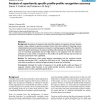179 search results - page 3 / 36 » Structure recognition on sequences with a neuro-fuzzy-system |
BMCBI
2004
13 years 8 months ago
2004
Background: Annotation of sequences that share little similarity to sequences of known function remains a major obstacle in genome annotation. Some of the best methods of detectin...
SIBGRAPI
2007
IEEE
14 years 2 months ago
2007
IEEE
This paper proposes a model-based methodology for recognizing and tracking objects in digital image sequences. Objects are represented by attributed relational graphs (or ARGs), w...
PAMI
2011
12 years 11 months ago
2011
—We present a discriminative part-based approach for human action recognition from video sequences using motion features. Our model is based on the recently proposed hidden condi...
JAIR
2010
13 years 7 months ago
2010
This paper discusses the problem of marrying structural similarity with semantic relatedness for Information Extraction from text. Aiming at accurate recognition of relations, we ...
BMCBI
2008
13 years 8 months ago
2008
Background: Residue depth allows determining how deeply a given residue is buried, in contrast to the solvent accessibility that differentiates between buried and solvent-exposed ...

